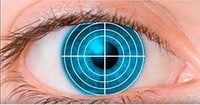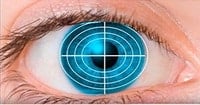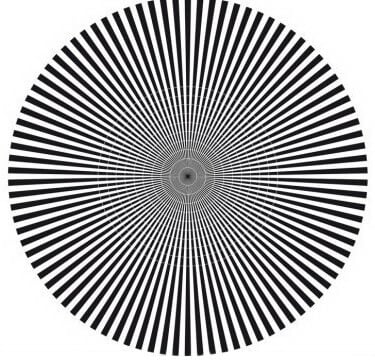What is astigmatism?
The term “astigmatism” in Latin means “missing (focal) point”. Astigmatism is an eye disorder in which a person sees objects in a blurry and/or distorted way.
Astigmatism is caused by an irregular (nonspherical) shape of the cornea (less often the lens). Normally, the healthy cornea and lens have an even, spherical surface.
With astigmatism, the refractive power of the surface of the cornea differs in different meridians, and light rays do not converge at the same point on the retina when passing through such a cornea.
What are the meridians of the eye?
The meridians of the eye are lines on the surface of the eyeball that are perpendicular to each other. One is vertical and the other is horizontal. In astigmatism, one of the meridians is flatter and the other is steeper. Accordingly, they have different refracting powers. The steeper meridian has greater refracting power.


Symptoms of astigmatism
It is essential to pay attention to the alarming symptoms in time, informing you of the necessity to visit an ophthalmologist as soon as possible.
Astigmatism may be evidenced by the following:
- Feeling of “sand” and burning in the eyes;
- Red eyes;
- Doubled or distorted vision;
- Inability to focus;
- Difficulties with spatial orientation, determining the distance to object;
- Rapid eye fatigue when reading, watching TV, working on a computer, sewing, etc;
- Decrease in visual acuity;
- Pain in the brow area;
- Frequent headaches.
Important!
Symptoms of this condition may be evident or barely noticeable. Only a specialist can determine whether something is threatening your vision. Do not neglect routine eye exams! Adults should visit an ophthalmology clinic at least once a year, children at the age of 3-12 months, 3, 5, 7 years old, and annually afterward.
Types of astigmatism
Astigmatism may be:
- Congenital and acquired (caused by corneal diseases, scarring after diseases or surgeries, keratoconus, trauma);
- Corneal (98.6% of cases) and lenticular (very rarely, 1.4% of cases);
- Direct (the vertical meridian has the greatest refracting power) and inverse (the horizontal meridian has the greatest refracting power).
Depending on the type of refractive error, astigmatism is classified as follows:
- Simple myopic astigmatism. Normal vision in one of the two meridians (horizontal or vertical) is combined with myopia).
- Compound myopic astigmatism. There is myopia in both meridians of the eye, but myopia is greater in one meridian and less in the other.
- Simple hyperopic astigmatism. Hyperopia in one of the meridians (hypermetropia) is combined with normal eyesight in the other meridian.
- Compound hyperopic astigmatism. There is hyperopia in both meridians, but hyperopia is higher in one meridian and lower in the other.
- Mixed astigmatism. There is myopia in one meridian and hyperopia in the other.
According to the astigmatism degree, a distinction is made between:
- Mild astigmatism up to 2 diopters;
- Moderate astigmatism up to 3 diopters;
- High astigmatism over 4 diopters.
What is physiological astigmatism?
Almost all people have mild corneal astigmatism (less than 0.5 diopters), which is called physiological astigmatism. It does not require correction as it does not have a strong impact on the quality of vision. At a young age, the visual system compensates for physiological astigmatism, but with time, it may become apparent. Often people do not even suspect that they have such astigmatism and it is only discovered during an eye exam.
Risks of astigmatism
Apart from blurred vision, astigmatism, especially of medium and high degrees, is often accompanied by asthenopia. This is a general feeling of poor well-being, dizziness, headaches, and sharp pain in the eyes. In addition, astigmatism greater than 2 diopters poses serious problems when choosing and making eyeglasses. If astigmatism is not corrected in childhood, it can lead to strabismus and amblyopia known as a permanent drop in vision.
Astigmatism diagnosis
To diagnose astigmatism accurately, a thorough examination of the visual system is required. In addition to testing visual acuity with special cylindrical lenses, a diagnosis may include:
- Refractometry, a complete analysis of the eye refraction;
- Corneal topography, a computerized tomography that examines the cornea and determines the degree of corneal astigmatism;
- Sciascopy (shadow test), an eye refraction test with a special light device known as a sciascope;
- Ultrasound and biomicroscopy (including ophthalmoscopy), an examination that allows determining the causes of astigmatism and examining all the eye structures in detail.
Other examination methods are also used to diagnose astigmatism, making it possible to detect this condition in patients of any age, starting from three months.

It is worthwhile understanding that professional diagnostics performed with modern high-precision equipment is an obligatory step on the way to good eyesight. Astigmatism, like many other eye diseases, should be treated without waiting for dangerous complications!
Ways to deal with astigmatism
Any type of astigmatism correction is aimed at “collecting” the refracted rays in one point on the retina. The most common method involves glasses with special optics, and recently special toric contact lenses have also been used. However, these apparently simple types of astigmatism correction entail certain difficulties.
With astigmatism, glasses with special cylindrical lenses are prescribed. They are selected and manufactured by highly qualified ophthalmologists and optometrists. In contrast to simple glasses, the prescription for astigmatic glasses contains data on the cylinder and its axis. However, these optics do not always solve the problem. They can cause unpleasant phenomena in patients with high astigmatism such as dizziness, eye pain, and visual discomfort. There are cases where glasses have to be constantly changed. Patients with astigmatism combined with myopia or hyperopia face particular difficulties. In this case, spherical cylindrical glasses are needed.
What are cylindrical glasses?
These are special pieces of glass shaped like a longitudinal slice of a cylinder. Their unique property consists in the fact that light rays falling on a plane parallel to the axis of the glass do not refract, but rays falling on a plane perpendicular to the axis are refracted. When prescribing glasses with cylindrical glasses, in addition to the refracting power, the ophthalmologist shall indicate the axis position of the glass. For this purpose, the international designation is used according to which degrees are counted from the horizontal meridian from right to left. To avoid the negative aspects of optical correction, modern ophthalmology offers more effective methods of astigmatism treatment such as laser correction, phakic lens implantation, and refractive crystalline lens replacement.
Astigmatism treatment at Eximer Ophthalmology Clinic
Eximer Ophthalmology Clinic employs the most up-to-date methods of astigmatism treatment. Therapy is always chosen individually, based on a thorough diagnostic examination of the visual system, depending on the type of disease and its degree.
Laser vision correction
Laser vision correction is achieved by changing the shape of the cornea (the natural refractive lens of the eye) through laser exposure. During such correction, the cornea is shaped individually for each patient. Laser correction is the best way to get rid of astigmatism (up to ±3.0 diopters). Eximer Ophthalmology Clinic offers the most advanced methods of laser correction, including femtosecond laser vision correction and Custom Vue personalized correction with aberrometry analysis.
Phakic lens implantation
Phakic toric lens implantation is applied to treat astigmatism of 0.75 up to 4 diopters in cases when laser correction is unavailable for some reason. A special phakic lens (basically an analog of a contact lens) is implanted into the posterior or anterior chamber of the eye through a micro-access of 1.8 mm.
Refractive lens exchange (lensectomy)
Refractive lens exchange is used to treat high astigmatism in cases when it is inexpedient to perform laser correction or the natural ability of the crystalline lens to accommodation is lost. The surgery consists in removing the transparent crystalline lens with concurrent implantation of an intraocular toric lens through a micro-access of 1.8 mm.
Astigmatism and myopia
Astigmatism often accompanies another refractive error called myopia. In combination, these conditions can cause serious discomfort. Standard optical correction cannot provide optimum visual characteristics, and special spherical glasses or toric contact lenses are necessary. The best way out in this case is laser vision correction.
Postoperative astigmatism
Postoperative astigmatism is a common occurrence after microsurgical procedures when the spherical shape of the cornea is disturbed after the surgery. In some cases, Postoperative astigmatism may be treated by laser correction. However, modern surgical techniques, such as cataract extraction, allow reducing the risk of postoperative astigmatism to a minimum or avoiding it entirely.
Astigmatism prevention
Preventive measures in astigmatism lie in following the rules of visual hygiene. This allows protecting the eyes from excessive strain and to some extent prevents further dangerous complications.
- Do all visual work with sufficient and even lighting.
- Alternate visual activity with physical activity, taking breaks from watching TV, working on the computer, reading, sewing, etc.
- Do eye exercises.
- Try to minimize the influence of unfavorable climatic conditions, such as cold, frost, wind (especially sand or dust), anything that can irritate the eyes.
You can get personal recommendations in more detail at the face-to-face meeting with an ophthalmologist. The doctor will tell you what to do in order to prevent the deterioration of the visual organs according to the type of astigmatism, its degree, the general state of the visual system, and the patient’s age.




